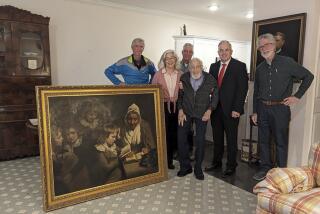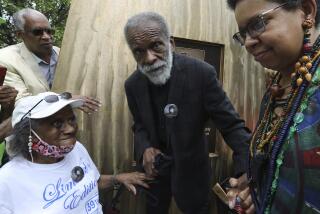James N. Wood dies at 69; chief of J. Paul Getty Trust helped restore its reputation
James N. Wood, who helped the J. Paul Getty Trust regain its good name as its president and chief executive over the last three years and led the Art Institute of Chicago through 24 years of growth, died Friday, Getty officials announced. He was 69.
Wood’s body was found late Friday at his Brentwood home, Getty spokesman Ron Hartwig said. A statement by the Getty Trust said Wood died of natural causes.
FOR THE RECORD:
James N. Wood obituary: The obituary of J. Paul Getty Trust President and Chief Executive James N. Wood in Sunday’s California section misspelled the last name of his daughter Rebecca Breen as Green. —
Wood had been expected to fly to Chicago on Friday morning for a meeting; when he failed to arrive, his wife, art historian and painter Emese Forizs, received a call in Rhode Island where she was with family, Hartwig said. Police and a senior Getty staff member were summoned to Wood’s home, where he was found dead.
“He was the exact kind of person the Getty wanted and needed,” said Mark S. Siegel, the trust’s chairman, who joined the board shortly before its president, Barry Munitz, resigned under fire in February 2006. Munitz’s resignation followed more than a year of revelations about questionable expenditures, poor morale and controversies over antiquities acquisitions.
Wood “was smart, kind, a good leader and a good collaborator, and he didn’t have a lot of ego about him. He was not a person who needed to be flashy or showy,” Siegel said.
Siegel was on the search committee that approached Wood about ending his semi-retirement in Bristol, R.I. Wood took over at the Getty in February 2007 — assuming command of the world’s richest visual art institution, with an endowment that’s now about $5 billion. Besides the Getty Museum in Brentwood and the Getty Villa collection of ancient Greek and Roman art near Malibu, the trust encompasses separate institutions for grant making, art scholarship and art conservation that give it a worldwide reach.
“He was a man of total probity, imaginative and flexible of mind and open to new ideas,” said Philippe de Montebello, former longtime director of New York’s Metropolitan Museum of Art, who knew Wood for more than 45 years. “But at the same time he was driven by a sense of purpose — he had no patience for flimflam and silliness. He was a serious man.”
James Nowell Wood, born March 20, 1941 in Boston, came to the Getty with nearly 30 years of experience leading prominent art museums: the St. Louis Art Museum from 1975 to 1980 and the Art Institute of Chicago from 1980 to 2004. He was also an art historian, specializing in European and American painting and sculpture as well as photography, with degrees from Williams College and New York University’s Institute for Fine Arts. From 1967 to 1975, he held curatorial and executive positions at the Metropolitan Museum and at the Albright-Knox Art Gallery in Buffalo, New York.
James Cuno, his successor at the Art Institute, said he got to know Wood well during the late 1990s. They organized a series of seminars for museum directors at Harvard, where Cuno was museum director and a professor.
“Every junior museum director, including myself, looked up to him as an example of a museum director with a clear moral bearing and a sense of regard for what was most important — that this was all done on behalf of the public and in the public’s trust,” Cuno told The Times on Saturday.
Among Wood’s key accomplishments at the Art Institute, Cuno said, were acquiring important modern and contemporary artworks, including a donated collection of surrealist works, and shepherding two new buildings that doubled its gallery space.
Wood stepped down in 2004, welcomed Cuno as his successor and went back to New England — not to retire, but to await another “project of importance and consequence,” Cuno said
At the Getty, his mandate was to instill stability within the institution and restore its credibility in the art world. Under his leadership the Getty became uncommonly open about its finances. It began posting financial statements on its website, including what its top executives earned — in Wood’s case, $998,235 annually, down from a peak of $1.11 million in 2007-08.
The Getty’s antiquities problem was allegedly smuggled works for which it couldn’t prove legitimate ownership dating before 1970, when the United Nations banned their export unless the country of origin approved. The Getty reached a settlement with Italy during Wood’s first year as president, following tense negotiations largely conducted by Michael Brand, the Getty Museum director who had been hired in 2005. The Getty returned 40 artworks, including some of its most treasured pieces, but secured a cooperative agreement in which the Italian government would lend equally significant museum pieces to be shown in L.A. on temporary exhibit.
By 2009, the British archaeologist Colin Renfrew, a leading critic of museums harboring ancient works of questionable origin, praised the Getty as a model for others, based on policies it had adopted to ensure that it would forgo acquisitions whose provenance was in doubt.
But Wood’s tenure became rocky. The Getty relies almost exclusively on its investment returns to fund operations, and the market meltdown in 2008-09 saw its endowment plummet 24%. Wood instituted severe staff reductions and executive pay cuts, saying that to do otherwise in a poor economy would put the Getty at risk of a “fall off a huge cliff.”
He already had begun restructuring the Getty’s spending priorities, and a dispute over who would control funds for art purchases was one source of friction between Wood and Brand, who resigned suddenly in January. Brand had been popular with museum staff, and some employees began venting their frustration on an anonymous blog. Some complained that Wood wasn’t receptive enough to staff members’ ideas — a notion he disputed.
In late April, Wood said the Getty’s investments had bounced back enough to increase the trust’s operating budget from $216 million to $245 million for the fiscal year that starts July 1. Wood said he was confident that a search for a new museum director that he launched in February would bring highly qualified candidates, despite the Getty’s unusual setup that makes the museum director a subordinate of the trust president, rather than the top executive.
Siegel, the Getty Trust chairman, called Wood’s unexpected death a double tragedy: the personal loss of a respected and accomplished human being, coupled with the institutional loss of a leader who, he said, had made great headway in unknotting a problem that had dogged the Getty since the 1980s: how to make the four branches, including the museum, function as a whole that is greater than the individual parts.
Siegel, an investment executive, said he had lunch with Wood in his office early last week and spoke with him by phone Thursday morning.
“We had a tremendously fun lunch together, and he seemed the picture of good health and happiness,” Siegel said. “He was so comfortable in his own skin, that he was a person other people felt comfortable just being around.”
In addition to his wife, Wood’s survivors include daughters Lenke Moscarelli of Providence, R.I., and Rebecca Green of San Francisco, and three granddaughters. Services will be private.
Times staff writers Ruben Vives and David Ng contributed to this report.
More to Read
Start your day right
Sign up for Essential California for the L.A. Times biggest news, features and recommendations in your inbox six days a week.
You may occasionally receive promotional content from the Los Angeles Times.







